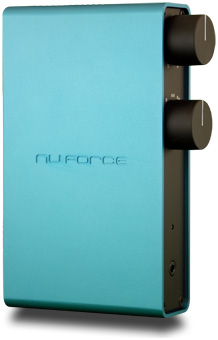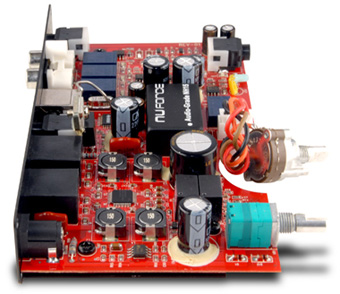 Nuforce Icon Integrated
Amplifier Nuforce Icon Integrated
Amplifier
There’s cute and there’s not cute. Puppies are
cute. Small children are usually cute. Large items (SUVs, refrigerators) are seldom cute.
The Incredible Hulk is not cute. Stereo equipment usually falls into the latter category.
Even small, crisply styled components aren’t often cute.
So how to explain my first impression of the NuForce Icon
integrated amplifier: "Gee, it’s cute"?
Description
The NuForce Icon ($249 USD) is about the size of a
paperback book -- 6"L x 4.5"W x 1"D -- and comes with a stand that holds it
firmly in a vertical orientation. It’s available in black, silver, blue, or the
attractive red of my review sample. It weighs one pound. Also included are a 24W outboard
power supply, a USB cord, and a pair of 1m-long, better-than-average speaker cables
terminated with RJ-45 networking plugs at the amp end, gold-plated banana plugs at the
other.
The Icon’s front panel is sparsely inhabited. Besides
the blue power-on LED and 3.5mm headphone jack, there are but two controls: a combination
Volume control and On/Off switch, and a three-position knob that selects among the three
inputs on the rear panel. The latter are a USB port for digital audio from a computer, a
3.5mm stereo jack for an iPod, and a pair of RCA jacks for more mundane sources (tuners,
CD players, etc.). Also on the rear is the coax power input, the two RJ-45 jacks for the
speaker outputs, and a line output to feed a subwoofer. The USB input brings into play an
internal 16-bit DAC that will sample up to 48kHz. Thus, the Icon can be used either as a
DAC-amplifier or, via its line output, as a DAC only, for digital sources. NuForce
suggests that the Icon be used with speakers of 87dB/2.83V/m or higher sensitivity.
The Icon is based on NuForce’s class-D integrated
circuit, which the company calls an "analog switching amplifier." A number of
reviewers believe that class-D amps have an almost tube-like sound; I know they’re
far more efficient than the more common class-AB designs. While other NuForce amps have
prodigious outputs, the Icon, intended to be used in personal stereos, emits a more modest
12Wpc.
System
 I wasn’t able to put the
Icon’s internal DAC to the test. Because Windows installed a driver for the "USB
Human Interface Product" (which is how Windows identified the Icon), I haven’t
been able to get any sound at all out of my computer. However, if its DAC section is as
capable as the rest of the Icon, it should pass the most critical muster. I wasn’t able to put the
Icon’s internal DAC to the test. Because Windows installed a driver for the "USB
Human Interface Product" (which is how Windows identified the Icon), I haven’t
been able to get any sound at all out of my computer. However, if its DAC section is as
capable as the rest of the Icon, it should pass the most critical muster.
My source was an Onkyo DX-6800 CD player, my speakers the
PSB Alpha Minis (89dB sensitivity). I used NuForce’s supplied speaker cable and
powered the Icon with both its standard 24W supply and an optional 42W supply ($29.95).
Never once did the Icon give me a moment’s problem.
In addition to the 42W power supply, NuForce sent me
another option: a higher grade of speaker cable ($29.95) designed, NuForce claims,
"for the audiophiles who demand higher performance than the standard speaker cable
that comes with the Icon package." While the upgraded power supply added to the
Icon’s bass performance, I noticed no difference between the standard 1m and the
optional 2m cables -- but then again, I wouldn’t expect to hear significant
differences between cables of such lengths. Another option is an adapter that changes the
speaker outputs from RJ-45s to standard binding posts so that non-NuForce speaker cables
can be used.
Sound
Wanting to first check out how the Icon would sound with
bass-laden, percussive music, I pulled out a standby: Paul Simon’s "You Can Call
Me Al," from Graceland (CD, Warner Bros. R2 78904). NuForce’s 42W power
supply showed its mettle, providing a very meaty midbass. The PSB Alpha Minis, which have
always astounded me with their bass performance, seemed a perfect match for the Icon.
Although there’s a lot going on in this song, there was no sense of lag from any
instrument, and the soundstaging was excellent, with Simon nicely out in front of his
band. The solo instruments -- electric and acoustic basses and a pennywhistle -- each
occupied an individual space just behind Simon’s voice. The pennywhistle, which can
sometimes sound shrill, was very well reproduced.
For further adventures in excess bass, I pulled out the
Trammps’ "Disco Inferno," from a compilation titled Pure Disco 3
(CD, Polydor 31456 5357-2). I was astounded. Even with its standard power supply, the Icon
kicked out the jams -- and the heavy-duty supply provided even more thumping pleasure.
This small but mighty amp could easily handle dense, heavily compressed audio.
Pure Disco 3 also includes Dionne Warwick and the
Spinners’ "Then Came You" -- a tune I’ve always thought had a great
bass line, interesting hooks, and fine vocals. The Icon shone brightly, creating a
soundstage both wide and deep: Warwick out in front, the lead Spinner right behind her and
just to her left, the other Spinners right behind him, and the instruments creating a
cocoon around the singers. Other than a broader soundstage with 42W, I heard no difference
in sound between the two power supplies.
For something completely different, I then played British
singer Claire Martin’s version of Joni Mitchell’s "Be Cool," from The
Waiting Game (CD, Honest/Linn CD 5018). The Icon and Alpha Minis created a perfect
cabaret setting, with Martin well out in front, the piano and guitar behind her but in
front of the bass and drums. The piano sounded quite realistic -- no Bösendorfer, but
serviceable (and in tune). A fine time was had by all, especially the listener.
Whenever I review an audio product, at some point I listen
to Manhattan Transfer’s cover of Weather Report’s "Birdland," from
their The Definitive Pop Collection (CD, Atlantic/Rhino R2 74111). This track is a
great challenge to an audio system’s resolution, soundstaging, and speed, and the
Icon-PSB system passed all three tests with flying colors. The voices, especially that of
Janis Siegel, were rock-solid in placement, and sounded natural. The clarity of the
reproduction of Siegel’s scatting at the end of this track was about as good as
I’ve heard. A very satisfying performance.
Aaron Copland is one of my favorite composers, and Hoedown,
from his ballet Rodeo, is one of my favorites of his compositions. David Zinman
leads the Baltimore Symphony Orchestra in this sprightly dance on an Argo CD (440639), and
the Icon-PSBs did it proud. If there was any shortcoming, it was that the high strings had
a bit more gloss or shimmer than I hear with my other systems -- and a bit more than I
remember hearing from the BSO in Baltimore’s Meyerhoff Symphony Hall, the
orchestra’s home and this recording’s venue. Even so, I enjoyed listening to
this track several times.
Conclusion
When I first opened its box, I really did think the NuForce
Icon was cute, and had the same level of expectation one often has of cute things: not
very high. Boy, did the Icon set me straight.
The Icon isn’t perfect. I tried it with my NEAR 50Me
Mk.II speakers (88dB sensitivity) in a larger room, and got the sense that the NuForce was
struggling with some material at fairly high levels: The highs tended to harden and become
glossy. All I had to do was back off the volume a bit and the problem went away, but I
think NuForce is smart to recommend its use with fairly sensitive speakers.
All in all, the NuForce Icon is a fantastic small
amplifier. I recommend it for any application in small spaces such as offices, bedrooms,
dorm rooms, etc. With a set of good, sensitive speakers and nearly any kind of music, the
NuForce Icon will give you a system that really satisfies.
. . . Thom Moon
Price of equipment reviewed
|